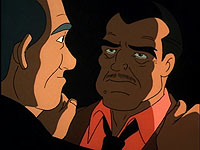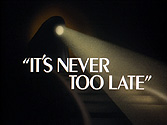|
||
|
| Credits | Cast | |
Story by Tom Ruegger Teleplay by Garin Wolf Directed by Boyd Kirkland Music by Lolita Ritmanis Animation by Spectrum |
Kevin Conroy as Bruce Wayne Bob Hastings as Commissioner Gordon Robert Constanzo as Bullock John Vernon as Rupert Thorne Townsend Coleman as Chick Paul Dooley as Father Michael Jeff Doucette as Gabe |
Linda Gary as Constance Blaine Katherine Helmond as Connie Peter Jason as Mason Alan Roberts as Young Arnie Eugene Roche as Stromwell Josh Weiner as Michael |

Bruce Timm on Boyd Kirkland's direction of “It’s Never Too Late”: "His storyboards were staged brilliantly. There's this one great shot on the storyboard. You're looking at a church and the camera pans to where a restaurant is. I found that it was the first time I actually thought of Gotham as a real place. It's easy for the city to be just a backdrop, but here it felt like it had geography." Possibly Kirkland’s attention to geography in “It’s Never Too Late” is merely fortuitous. I prefer to believe it is design. After all, of all the directors who worked on the series’ first iteration, Kirkland was the most attentive to the ways that staging could create or enhance psychology. Consider, for instance, the claustrophobic apartment fight that highlights “Appointment in Crime Alley": there Kirkland makes a darkened apartment a trap, first for a woman terrorized by thugs and then for the thugs as they are terrorized by Batman. Consider, too, the obsessive fanboy’s fondling of his toys in “Beware the Gray Ghost": the Bruce Timm caricature winds himself up for the showdown by winding up his dolls. And consider the at-a-distance point-of-view from which Bruce Wayne watches his alter ego take down a gang of robbers in “Perchance to Dream,”: by showing the scene from something like Wayne's point-of-view, Kirkland puts us inside Wayne's head. In each of these sequences—and examples could be multiplied—the form of the action is more important than the action itself, because it’s the form that gives us the meaning. Kevin Altieri gave his episodes greater visual flair and kinetic energy, but Kirkland—even in his most meretricious offerings—grasped and presented us with BTAS’s very noir heart. In “It’s Never Too Late” Kirkland assays the geographies of place, time, and memory. Most obviously, he twins the present and the past by stimulating Stromwell’s flashbacks with objects and locations. But when he does that pan from the church to the restaurant, he gives us both an economical, cinematic “cut” and a statement of theme: He takes us from the realm of “higher” things to the gutter; and he uses that church, which looms recurrently in the background, and from which Batman and Father Michael plot Stromwell's redeption, to observe and dominate the actions of the oblivious Stromwell. But it is with the continuity that Kirkland excels. The story is not only about redemption but about the sinner’s progress. His psychology of temporary escape, eternal pursuit, and inevitable confrontation with both his misdeeds and his moment of grace are dramatized by Kirkland’s terrier-after-a-rat construction. Many action shows (and movies) cheat on their chases and escapes: they show endless loops of people running, punctuated by shots of them popping out of inexplicable hiding places. But Kirkland gives us the geography of the chase, always showing us how Stromwell gets from one rat hole to another; he can escape Batman or Thorne’s gang, but he cannot escape his remorseless director. The effect—remarkable here as it is in the open vistas of “Sideshow”—is of claustrophobia, of a man suffocated by unyielding pursuit. The story itself is melodramatic and more than a little manipulative, defects even the most skilled direction cannot altogether expunge. But Kirkland makes Stromwell’s exhaustion and surrender feel earned. It’s always dangerous to pin the virtues of an episode on one man, but a glance at Kirkland’s resume should justify the sense that he is primarily responsible for lifting “It’s Never Too Late” above the level of routine. Still, in the sense of fairness, let us also mention his storyboard artists on this episode: Curt Geda, Doug Murphy, and Philip Norwood. |
|
Production Notes Boyd Kirkland: "This is one of my favorite shows [because] ... Batman is not driving around playing catch-up. He knows what's going on and is behind the scenes manipulating the situation to serve his ends. To me, this is the epitome of how Batman should be portrayed." |
|
Related Episodes |
What Others Are Saying ... |
| Back to I Am the Night |
Forward to I've Got Batman in My Basement |

